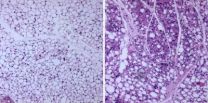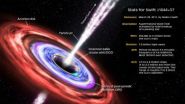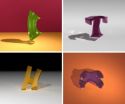(Press-News.org) ATLANTA – Results from a study conducted at Georgia State University suggest that a "fight" between bacteria normally living in the intestines and the immune system, kicked off by another type of bacteria, may be linked to two types of chronic disease.
The study suggests that the "fight" continues after the instigator bacteria have been cleared by the body, according to Andrew Gewirtz, professor of biology at the GSU Center for Inflammation, Immunity and Infection. That fight can result in metabolic syndrome, an important factor in obesity, or inflammatory bowel disease (IBD).
The results were published in the journal Cell Host & Microbe.
"The implication at present is that it is very important to control the early environment," Gewirtz said. "We need to examine how this can be achieved – perhaps via breastfeeding, a more diverse diet, probiotics are possibilities."
The study's results are important as instances of chronic diseases like metabolic syndrome and IBD are increasing rapidly among humans, he explained.
Metabolic syndrome involves risk factors, including obesity, which can lead to cardiovascular disease, diabetes and stroke. According to the American Heart Association, about 35 percent of adults are affected by this syndrome.
IBD, which includes Crohn's disease and ulcerative colitis, happens when the intestines become inflamed, leading to abdominal cramps and pain, diarrhea, weight loss and bleeding.
More than 600,000 Americans annually have some kind of inflammatory bowel disease, according to the American Academy of Family Physicians.
Bacteria normally live in the gut of humans, with the average human having about 4 pounds of bacteria living there.
"It is increasingly apparent that bacteria are playing a role in healthy development, and need to be properly managed by the mucosal immune system to avoid inflammatory diseases" Gewirtz explained.
###The study team included Gewirtz, Frederic Carvalho, Omry Koren, Julia Goodrich, Malin Johannson, Ilke Nalbantoglu, Jesse Aitken, Yueju Su, Benoit Chassing, William Walters, Antonio Gonzalez, Jose Clemente, Tyler Cullender, Nicolas Barnich, Arlette Darfeuille-Michaud, Matam Vijay-Kumar, Rob Knight and Ruth Ley.
Participating institutions included GSU's Center for Inflammation, Immunity and Infection and the Department of Biology; Clermont University of the Universite d'Auvergne in France; Insern; the Department of Microbiology of Cornell University; the Department of Medical Biochemistry of the University of Gothenberg in Sweden; and the Department of Pathology and Immunology of the Washington University School of Medicine in St. Louis, Mo.
Additional institutions involved included the Department of Cellular, Molecular and Developmental Biology, the Department of Computer Science and the Department of Chemistry and Biochemistry of the University of Colorado at Boulder; and the Howard Hughes Medical Institute.
The study, "Transient inability to manage Proteobacteria drives gut inflammation in TLR5-deficient mice," appears in the August 16 print edition of the journal Cell Host & Microbe.
For more about the Center for Inflammation, Immunity and Infection at GSU, visit http://inflammation.gsu.edu.
Bacteria-immune system 'fight' can lead to chronic diseases, study suggests
2012-08-03
ELSE PRESS RELEASES FROM THIS DATE:
Research could lead to improved oil recovery, better environmental cleanup
2012-08-03
CORVALLIS, Ore. – Researchers have taken a new look at an old, but seldom-used technique developed by the petroleum industry to recover oil, and learned more about why it works, how it could be improved, and how it might be able to make a comeback not only in oil recovery but also environmental cleanup.
The technology, called "microbial enhanced oil recovery," was first developed decades ago, but oil drillers largely lost interest in it due to its cost, inconsistent results and a poor understanding of what was actually happening underground.
The new findings by engineers ...
New target for treating diabetes and obesity
2012-08-03
AUDIO:
Researchers at Washington University School of Medicine in St. Louis have identified a potential target for treating diabetes and obesity. They discovered that when a particular protein is disabled in...
Click here for more information.
Researchers at Washington University School of Medicine in St. Louis have identified a potential target for treating diabetes and obesity.
Studying mice, they found that when the target protein was disabled, the animals became more ...
Judging the role of religion in law
2012-08-03
There's a passage in the Old Testament's Deuteronomy that says if a case too difficult to decide comes before the courts, it should be brought to the Levite priests who will render a verdict in God's name. However, one University of Alberta researcher says that may be taking religious freedom a step too far.
Sarah Hamill, a doctoral student in the Faculty of Law, recently published an article in response to a premise that said judges who lack direction-setting precedence in cases should use religious-based reasoning. Hamill contends that—aside from being a serious breach ...
Deep-sea squid can 'jettison arms' as defensive tactic
2012-08-03
KINGSTON, R.I. – August 2, 2012 – A postdoctoral researcher at the University of Rhode Island has observed a never-before-seen defensive strategy used by a small species of deep-sea squid in which the animal counter-attacks a predator and then leaves the tips of its arms attached to the predator as a distraction.
Stephanie Bush said that when the foot-long octopus squid (Octopoteuthis deletron) found deep in the northeast Pacific Ocean "jettisons its arms" in self-defense, the bioluminescent tips continue to twitch and glow, creating a diversion that enables the squid ...
Vaporizing the Earth
2012-08-03
In science fiction novels, evil overlords and hostile aliens often threaten to vaporize the Earth. At the beginning of The Hitchhikers Guide to the Galaxy, the officiously bureaucratic aliens called Vogons, authors of the third-worst poetry in the universe, actually follow through on the threat, destroying the Earth to make way for a hyperspatial express route.
"We scientists are not content just to talk about vaporizing the Earth," says Bruce Fegley, professor of earth and planetary sciences at Washington University in St. Louis, tongue firmly in cheek. "We want to understand ...
'Cry' of a shredded star heralds a new era for testing relativity
2012-08-03
Last year, astronomers discovered a quiescent black hole in a distant galaxy that erupted after shredding and consuming a passing star. Now researchers have identified a distinctive X-ray signal observed in the days following the outburst that comes from matter on the verge of falling into the black hole.
This tell-tale signal, called a quasi-periodic oscillation or QPO, is a characteristic feature of the accretion disks that often surround the most compact objects in the universe -- white dwarf stars, neutron stars and black holes. QPOs have been seen in many stellar-mass ...
Extinction risk factors for New Zealand birds today differ from those of the past
2012-08-03
Durham, NC – What makes some species more prone to extinction? A new study of nearly 300 species of New Zealand birds — from pre-human times to the present — reveals that the keys to survival today differ from those of the past.
The results are important in light of the growing number of studies that try to predict which species could be lost in the future based on what kinds of species are considered most threatened today, said lead author Lindell Bromham of Australian National University.
In the roughly 700 years since humans arrived in the remote islands that make ...
Notre Dame research into oaks helps us understand climate change
2012-08-03
Jeanne Romero-Severson, associate professor of biological sciences at the University of Notre Dame, and her collaborators, are tracking the evolution of the live oaks of eastern North America, seeking to understand how the trees adapted to climate change during glacial periods.
When the ice advanced, the oaks retreated. When the ice retreated the oaks advanced, spreading from tropical to temperate zones, up from Central America and Mexico into the Piedmont Carolinas. The researchers expect the study of live oak migrations and phylogeny will provide clues to the success ...
No bones about it
2012-08-03
Computer-generated characters have become so lifelike in appearance and movement that the line separating reality is almost imperceptible at times. "The Matrix" sequels messed with audiences' perceptions of reality (in more ways than one) with action scenes mixing CG characters and real actors. Almost a decade later, superheroes and alien warriors dominate the multiplex. But while bipeds and quadrupeds have reigned supreme in CG animation, attempts to create and control their skeleton-free cousins using similar techniques has proved time-consuming and laborious.
Georgia ...
Speaking multiple languages can influence children's emotional development
2012-08-03
On the classic TV show "I Love Lucy," Ricky Ricardo was known for switching into rapid-fire Spanish whenever he was upset, despite the fact Lucy had no idea what her Cuban husband was saying. These scenes were comedy gold, but they also provided a relatable portrayal of the linguistic phenomenon of code-switching.
This kind of code-switching, or switching back and forth between different languages, happens all the time in multilingual environments, and often in emotional situations. In a new article in the July issue of Perspectives on Psychological Science, a journal ...



